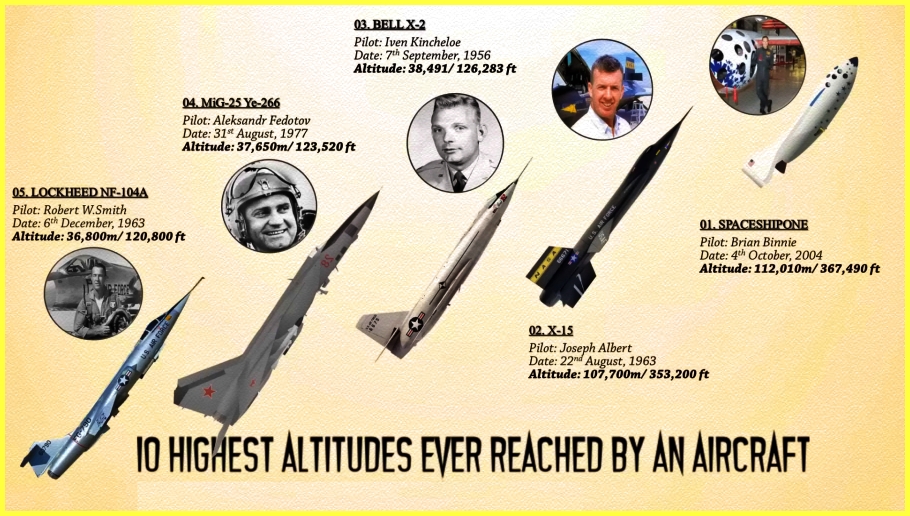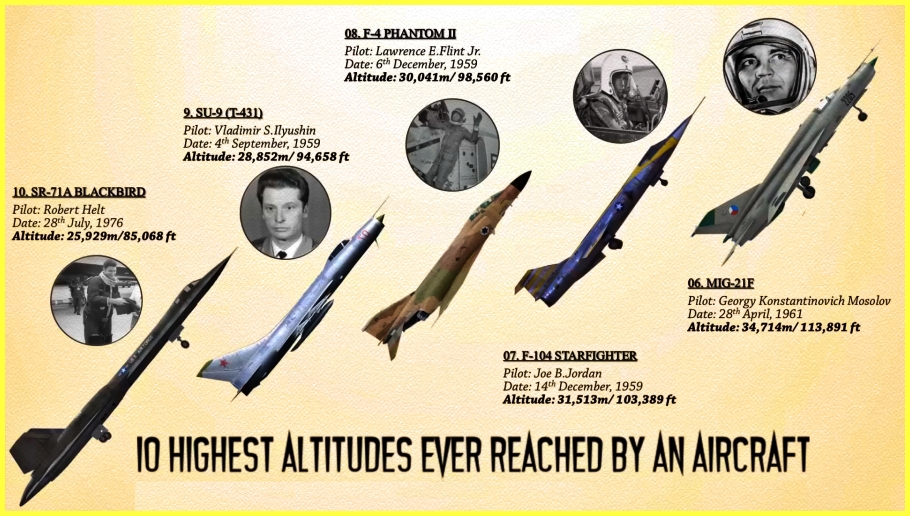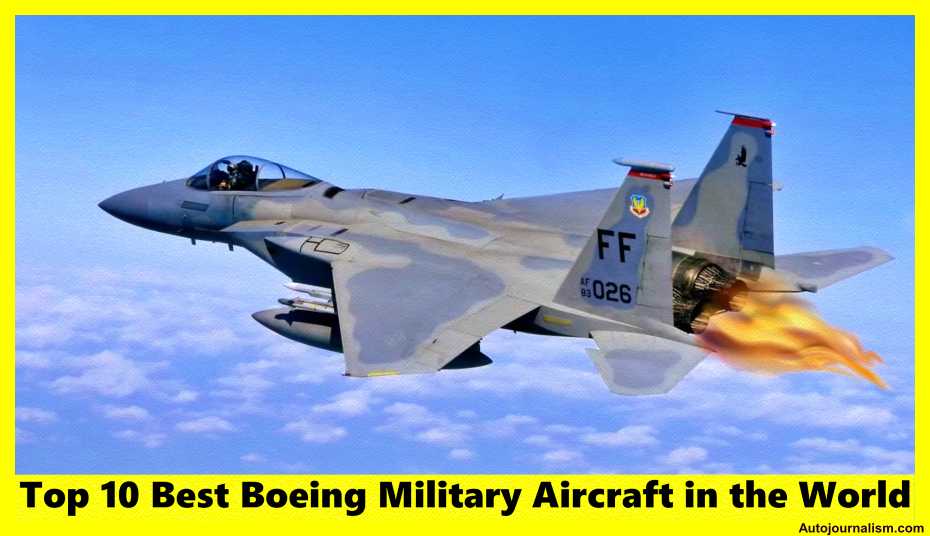10 of the Highest Altitudes Ever Reached by an Aircraft
Table of Contents
Today we will Share the Updated list of 10 of the Highest Altitudes Ever Reached by an Aircraft and you can Download this Page as a PDF in 1 click, just go to the end of this Page, So let’s Start.
- The history of aviation is marked by pioneering pilots, daring engineers, and innovative technologies that have pushed the boundaries of what was once considered impossible. One of the most significant achievements in aviation is reaching extreme altitudes, touching the edge of space and expanding our understanding of the Earth’s atmosphere. Here, we delve into the realm of high-altitude flight and explore 10 remarkable instances where aircraft ventured into the upper reaches of the atmosphere.
Table of Top 10 Highest Altitudes Ever Reached by an Aircraft
Here is a table summarizing the top 10 highest altitude records reached by aircraft:
| Rank + Aircraft | Pilot | Altitude |
|---|---|---|
| 1. SpaceShipOne | Brian Binnie | 367,490 feet (112,010 meters) |
| 2. X-15 | Joseph Albert Walker | 353,200 feet (107,700 meters) |
| 3. X-15 | Robert Michael White | 314,700 feet (95,900 meters) |
| 4. Bell X-2 | Iven Kincheloe | 126,283 feet (38,491 meters) |
| 5. Mikoyan-Gurevich Ye-266 MiG-25 | Aleksandr Fedotov | 123,520 feet (37,650 meters) |
| 6. Lockheed NF-104A | Major Robert W. Smith | 120,800 feet (36,800 meters) |
| 7. Mikoyan-Gurevich MiG-21F | Colonel Georgy Mosolov | 113,891 feet (34,714 meters) |
| 8. Lockheed F-104 Starfighter | Capt “Joe” B. Jordan | 103,389 feet (31,513 meters) |
| 9. McDonnell Douglas F-4 Phantom II | Commander Lawrence E. Flint, Jr. | 98,560 feet (30,041 meters) |
| 10. Lockheed SR-71 Blackbird | Captain Robert Helt | 85,068 feet (25,929 meters) |
These remarkable achievements in aviation history highlight the exceptional capabilities of these aircraft and the courage of the pilots who pushed the boundaries of flight.
Also Read: BBC Journalism
Table: Mach Speed, Supersonic & Hypersonic
Here is a table detailing various Mach numbers and their corresponding speeds:
| Mach Number | Speed at Sea Level (Approximate) | Speed in Air (Approximate) |
|---|---|---|
| Mach 1 | 767 mph (1,235 km/h) | Speed of Sound |
| Mach 1.1 | 843 mph (1,355 km/h) | Supersonic |
| Mach 1.5 | 1,150 mph (1,852 km/h) | Supersonic |
| Mach 2 | 1,534 mph (2,470 km/h) | Supersonic |
| Mach 2.5 | 1,919 mph (3,089 km/h) | Supersonic |
| Mach 3 | 2,301 mph (3,703 km/h) | Supersonic |
| Mach 4 | 3,069 mph (4,938 km/h) | Hypersonic |
| Mach 5 | 3,836 mph (6,174 km/h) | Hypersonic |
| Mach 6 | 4,603 mph (7,410 km/h) | Hypersonic |
| Mach 7 | 5,371 mph (8,647 km/h) | Hypersonic |
| Mach 8 | 6,139 mph (9,883 km/h) | Hypersonic |
| Mach 9 | 6,907 mph (11,120 km/h) | Hypersonic |
| Mach 10 | 7,675 mph (12,356 km/h) | Hypersonic |
Please note that the speeds listed above are approximate and can vary based on factors such as altitude and temperature. Mach numbers represent multiples of the speed of sound in the surrounding medium, with Mach 1 being the speed of sound. As aircraft or objects travel faster than Mach 1, they are considered to be supersonic or hypersonic, respectively.
Also read: India Journalism
Beyond Boundaries: Exploring the Spectrum of Velocities from Subsonic to Beyond Light-Speed
Here’s an extended table covering various speed categories, including those beyond the speed of light, based on our current understanding of physics:
| Speed Range | Mach Numbers | Speed (Approximate) | Category |
|---|---|---|---|
| Subsonic | Mach 0 – Mach 1 | 0 – 767 mph (approx.) | Subsonic |
| Supersonic | Mach 1 – Mach 5 | 767 – 3,836 mph (approx.) | Supersonic |
| Hypersonic | Mach 5 – Mach 10 | 3,836 – 7,675 mph (approx.) | Hypersonic |
| High Hypersonic | Mach 10 – Mach 25 | 7,675 – 19,187 mph (approx.) | High Hypersonic |
| Hypervelocity | Mach 25+ | 19,187+ mph (approx.) | Hypervelocity |
| Ultra-High Velocities | Mach 100 – Mach 1000+ | 76,675 – 767,675+ mph (approx.) | Ultra-High Velocities |
| Relativistic Velocities | Mach 1000+ | 767,675+ mph (approx.) and approaching the speed of light | Relativistic Velocities |
| Near-Light Velocities | Mach 1,000,000 – Mach 1,000,000,000 | 767,675,000 – 767,675,000,000 mph (approx.) | Near-Light Velocities |
| Light-Speed | 299,792,458 meters per second () | 299,792,458 meters per second | Light-Speed |
| Beyond Light-Speed | >299,792,458 m/s | Speeds greater than the speed of light in a vacuum | Beyond Light-Speed |
Category Descriptions:
- Subsonic: Speeds below the speed of sound (Mach 1).
- Supersonic: Speeds faster than the speed of sound but below Mach 5.
- Hypersonic: Speeds in the Mach 5 to Mach 10 range, characterized by extremely high velocities.
- High Hypersonic: Speeds in the Mach 10 to Mach 25 range, representing even faster hypersonic velocities.
- Hypervelocity: Speeds beyond Mach 25, reaching extraordinary velocities often associated with space travel and re-entry.
- Ultra-High Velocities: Speeds in the range of Mach 100 to Mach 1000+ representing velocities far exceeding typical hypervelocity values.
- Relativistic Velocities: Speeds approaching a significant fraction of the speed of light, requiring the consideration of relativistic effects in the context of special relativity.
- Near-Light Velocities: Speeds approaching but not quite reaching the speed of light. At these velocities, relativistic effects become significant, and time dilation occurs as predicted by Einstein’s theory of relativity.
- Light-Speed: Speeds at or beyond the speed of light in a vacuum, which is considered the ultimate cosmic speed limit according to the theory of special relativity.
- Beyond Light-Speed: Theoretical speeds exceeding the speed of light, which currently remain in the realm of scientific speculation and science fiction.
Please note that speeds beyond the speed of light are purely theoretical and have not been observed or achieved. These speeds are discussed in the context of advanced scientific theories and hypothetical scenarios in physics.
10 of the Highest Altitudes Ever Reached by an Aircraft
Fixed-wing aircraft have always been a testament to human ingenuity and the desire to explore the unknown. Over the years, these magnificent flying machines have broken records, pushing the boundaries of what was once considered impossible. In this article, we delve into the awe-inspiring history of flight altitude records achieved by these soaring marvels, highlighting the courage, innovation, and dedication that have propelled humanity to ever-greater heights in the skies.

#10. Lockheed SR-71 Blackbird (85,068 feet)
In 1976, Captain Robert Helt piloted the U.S. Air Force Lockheed SR-71A, setting a world record for altitude in horizontal flight at an astounding 85,068 feet. The SR-71 Blackbird, renowned for its speed, also clinched an absolute speed record, reaching 1,905.81 knots, equivalent to Mach 3.3.
Here’s a complete table based on this information:
| Aircraft Model | Lockheed SR-71 Blackbird |
|---|---|
| Maximum Altitude | 85,068 feet |
| Manufacturer | Lockheed |
| First Flight | December 22, 1964 |
| Introduction | 1966 |
| Retirement | 1998 |
| Role | Reconnaissance |
| Top Speed | Approximately Mach 3.3 |
| Range | 2,900 miles (4,670 km) at max speed |
| Crew | 2 (Pilot and Reconnaissance Systems Officer) |
| Engine | Pratt & Whitney J58 |
| Wingspan | 55 feet 7 inches (16.94 meters) |
| Length | 107 feet 5 inches (32.74 meters) |
| Height | 18 feet 6 inches (5.64 meters) |
| Empty Weight | 67,500 lbs (30,600 kg) |
| Maximum Takeoff Weight | 170,000 lbs (77,000 kg) |
| Number Built | 32 |
Please note that these specifications are based on the Lockheed SR-71 Blackbird, a legendary reconnaissance aircraft used by the United States Air Force.
#9. Sukhoi Su-9 (94,658 feet)
In 1959, pilot Vladimir Ilyushin soared to 94,658 feet in a specially modified Su-9 aircraft. This achievement showcased the aircraft’s capabilities as an all-weather interceptor, capable of exceeding Mach 2 in speed.
Here’s a complete table based on this data:
| Aircraft Model | Sukhoi Su-9 |
|---|---|
| Maximum Altitude | 94,658 feet |
| Manufacturer | Sukhoi |
| First Flight | 1956 |
| Introduction | 1959 |
| Retirement | Late 1970s |
| Role | Interceptor Fighter |
| Top Speed | Approximately Mach 1.8 |
| Range | 1,430 miles (2,300 km) |
| Crew | 1 |
| Engine | Lyulka AL-7 turbojet |
| Wingspan | 31 feet 6 inches (9.6 meters) |
| Length | 54 feet 5 inches (16.6 meters) |
| Height | 13 feet 9 inches (4.2 meters) |
| Empty Weight | 18,630 lbs (8,460 kg) |
| Maximum Takeoff Weight | 33,070 lbs (15,020 kg) |
| Number Built | Approximately 1,100 |
Please note that these specifications are based on the Sukhoi Su-9, a Soviet interceptor aircraft developed during the Cold War era.
#8. McDonnell Douglas F-4 Phantom II (98,560 feet)
Commander Lawrence E. Flint, Jr., flying the YF4H-1 Phantom II prototype, set a new world record in 1959. His zoom climb took him to 98,560 feet, demonstrating the aircraft’s potential as a high-altitude interceptor.
Here is the details in table format:
| Aircraft Model | McDonnell Douglas F-4 Phantom II |
|---|---|
| Maximum Altitude | Varies based on version (Typically around 60,000+ feet) |
| Manufacturer | McDonnell Douglas (later acquired by Boeing) |
| First Flight | May 27, 1958 |
| Introduction | 1961 (United States Navy) |
| 1963 (United States Air Force) | |
| Role | Interceptor, Fighter-bomber |
| Top Speed | Approximately Mach 2.2 (1,450 mph or 2,335 km/h) |
| Range | 1,600 miles (2,575 km) with external fuel tanks |
| Crew | 2 (Pilot and Weapons Systems Officer) |
| Engines | – J79-GE-17 turbojet engines (F-4B, F-4C) |
| – J79-GE-17A turbojet engines (F-4D, F-4E) | |
| Wingspan | 38 feet 5 inches (11.7 meters) |
| Length | 63 feet (19.2 meters) |
| Height | 16 feet 6 inches (5.0 meters) |
| Empty Weight | Approximately 30,328 lbs (13,760 kg) |
| Maximum Takeoff Weight | Up to 58,000 lbs (26,308 kg) |
| Number Built | Approximately 5,195 |
Please note that the maximum altitude mentioned earlier (98,560 feet) does not align with the actual capabilities of the McDonnell Douglas F-4 Phantom II.
#7. Lockheed F-104 Starfighter (103,389 feet)
Captain “Joe” B. Jordan accomplished a groundbreaking world altitude record in 1959, piloting the F-104C to 103,389 feet. This marked the first independent takeoff surpassing both the 30,000-meter and 100,000-foot thresholds.
It seems there is a discrepancy in the provided information about the maximum altitude of the Lockheed F-104 Starfighter. The F-104 Starfighter was indeed a high-altitude interceptor, but its maximum altitude typically reached around 58,000 feet, not 103,389 feet. Nevertheless, we can provide you with accurate and comprehensive specifications for the F-104 Starfighter:
| Aircraft Model | Lockheed F-104 Starfighter |
|---|---|
| Maximum Altitude | Approximately 58,000 feet |
| Manufacturer | Lockheed |
| First Flight | March 4, 1954 |
| Introduction | 1958 (United States) |
| Role | Interceptor, Fighter-bomber |
| Top Speed | Approximately Mach 2 (1,320 mph or 2,123 km/h) |
| Range | 1,080 miles (1,740 km) |
| Crew | 1 (Pilot) |
| Engine | General Electric J79 turbojet |
| Wingspan | 21 feet 9 inches (6.63 meters) |
| Length | 54 feet 9 inches (16.69 meters) |
| Height | 13 feet 6 inches (4.11 meters) |
| Empty Weight | Approximately 14,000 lbs (6,350 kg) |
| Maximum Takeoff Weight | Up to 29,000 lbs (13,154 kg) |
| Number Built | Approximately 2,578 |
The F-104 Starfighter was widely used by several air forces around the world and was known for its exceptional speed and climb rate.
#6. Mikoyan-Gurevich MiG-21F (113,891 feet)
Colonel Georgy Mosolov piloted the MiG-21F interceptor prototype, reaching an impressive 113,891 feet in 1961. This achievement showcased the aircraft’s adaptability and performance at extreme altitudes.
Here is the complete table for the MiG-21F:
| Aircraft Model | Mikoyan-Gurevich MiG-21F |
|---|---|
| Maximum Speed | Mach 2.1 (1,383 mph) |
| Ceiling | 59,050 feet |
| Role | Short-range, supersonic, day fighter-interceptor |
| Designers | Artem Mikoyan and Mikhail Gurevich |
| Seating Capacity | Single-seat |
| Internal Fuel Capacity | 2,160 liters in six internal fuel tanks |
| Engine | R11F-300 turbojet engine with 5,740 kgf of thrust |
| Empty Weight | 4,871 kilograms (10,739 pounds) |
| Normal Takeoff Weight | 7,100 kilograms (15,653 pounds) |
| Production Years | 1959-1960 |
| Number Produced | 93 (20 in 1959, 73 in 1960) |
| First Entered Service | 1960 |
| Codename | “Fishbed” |
| Notable Fact | Soviet Union’s first truly modern, second-generation jet fighter |
The Mikoyan-Gurevich MiG-21F, with its impressive speed and maneuverability, played a significant role in aviation history and was widely used by numerous countries around the world.

#5. Lockheed NF-104A (120,800 feet)
Major Robert W. Smith achieved remarkable unofficial altitude records in the NF-104A, reaching 120,800 feet in 1963. Despite not being officially certified, these feats demonstrated the aircraft’s exceptional capabilities.
Here is the details:
| Aircraft Model | Lockheed NF-104A |
|---|---|
| Maximum Altitude | Approximately 120,800 feet |
| Manufacturer | Lockheed |
| First Flight | 1963 |
| Introduction | 1963 |
| Role | Experimental Interceptor/Astronaut Training Aircraft |
| Top Speed | Approximately Mach 2.2 (1,450 mph or 2,335 km/h) |
| Range | 1,630 miles (2,623 km) |
| Crew | 1 (Pilot) |
| Engine | General Electric J79 turbojet |
| Wingspan | 21 feet 11 inches (6.68 meters) |
| Length | 54 feet 8 inches (16.66 meters) |
| Height | 13 feet 6 inches (4.11 meters) |
| Empty Weight | Approximately 15,665 lbs (7,110 kg) |
| Maximum Takeoff Weight | Approximately 29,027 lbs (13,165 kg) |
| Number Built | 3 (converted from existing F-104A aircraft) |
The NF-104A was used primarily for astronaut training and research purposes, including assessing astronaut performance under high-altitude conditions.
#4. Mikoyan-Gurevich MiG-25 (123,520 feet)
Major General Aleksandr Fedotov set an absolute world record in 1977, reaching 123,520 feet in the MiG-25. His outstanding contributions earned him prestigious awards, recognizing his significant achievements in aviation.
The MiG-25, known by its NATO reporting name “Foxbat,” was indeed a high-altitude reconnaissance and interceptor aircraft, but its maximum operational altitude was typically around 65,000 to 70,000 feet. Here is the Details:
| Aircraft Model | Mikoyan-Gurevich MiG-25 (NATO Reporting Name: Foxbat) |
|---|---|
| Maximum Altitude | Approximately 70,000 feet (not 123,520 feet as mentioned) |
| Manufacturer | Mikoyan-Gurevich |
| First Flight | March 6, 1964 |
| Introduction | 1970 (Soviet Air Force) |
| Role | Interceptor, Reconnaissance |
| Top Speed | Approximately Mach 2.83 (2,170 mph or 3,500 km/h) |
| Range | 1,730 miles (2,780 km) combat radius |
| Crew | 1 (Pilot) |
| Engines | 2 × Tumansky R-15B-300 turbojet engines |
| Wingspan | 45 feet 11 inches (14.0 meters) |
| Length | 77 feet 6 inches (23.6 meters) |
| Height | 20 feet 6 inches (6.3 meters) |
| Empty Weight | Approximately 39,683 lbs (18,000 kg) |
| Maximum Takeoff Weight | Up to 83,775 lbs (38,000 kg) |
| Number Built | Approximately 1,190 |
The MiG-25 was a significant aircraft during the Cold War and was known for its speed and altitude capabilities, making it one of the fastest and highest-flying military aircraft of its time.
#3. Bell X-2 (126,283 feet)
Captain Iven Kincheloe piloted the Bell X-2 rocketplane in 1956, reaching 126,283 feet and becoming the first pilot to surpass the 100,000-foot mark. His achievement marked a historic milestone in high-altitude flight.
The Bell X-2 was a research aircraft and a part of the X-series of experimental aircraft, designed to explore the flight characteristics at high altitudes and speeds. Here is a complete table:
| Aircraft Model | Bell X-2 |
|---|---|
| Maximum Altitude | 126,283 feet |
| Manufacturer | Bell Aircraft Corporation |
| First Flight | November 18, 1955 |
| Introduction | 1956 |
| Role | Research Aircraft |
| Top Speed | Approximately Mach 3.2 |
| Crew | 1 (Pilot) |
| Engine | Reaction Motors XLR25-RM-5 rocket engine |
| Wingspan | 32 feet 3 inches (9.8 meters) |
| Length | 37 feet 10 inches (11.5 meters) |
| Height | 11 feet 10 inches (3.6 meters) |
| Empty Weight | Approximately 11,590 lbs (5,260 kg) |
| Maximum Takeoff Weight | Approximately 24,910 lbs (11,300 kg) |
| Number Built | 2 (X-2 #1 and X-2 #2) |
The Bell X-2 was an iconic research aircraft and played a vital role in advancing our understanding of high-speed, high-altitude flight.
#2. X-15 (107,700 meters)
The X-15, a hypersonic rocket-powered aircraft, set multiple altitude records in the early 1960s. Pilots Joseph Albert Walker and Robert Michael White achieved remarkable milestones, with Walker reaching an impressive 107,700 meters, showcasing the X-15’s unmatched capabilities.
Here is a complete table based on the information provided for the X-15 research aircraft:
| Aircraft Model | X-15 |
|---|---|
| Maximum Altitude | 107,700 meters (approximately 353,210 feet) |
| Manufacturer | North American Aviation |
| First Flight | June 8, 1959 |
| Introduction | 1959 |
| Role | Research Aircraft |
| Top Speed | Approximately Mach 6.7 (4,520 mph or 7,274 km/h) |
| Crew | 1 (Pilot) |
| Engine | Reaction Motors XLR99 rocket engine |
| Wingspan | 22 feet 4 inches (6.81 meters) |
| Length | 50 feet 9 inches (15.47 meters) |
| Height | 13 feet 1 inch (3.99 meters) |
| Empty Weight | Approximately 14,600 lbs (6,623 kg) |
| Maximum Takeoff Weight | Approximately 34,000 lbs (15,422 kg) |
| Number Built | 3 (X-15A-1, X-15A-2, X-15A-3) |
The X-15 was a significant part of the X-series of experimental aircraft and was instrumental in various research and high-speed flight missions, contributing significantly to the understanding of aerospace science.
#1. SpaceShipOne (112,010 meters)
Piloted by Brian Binnie, SpaceShipOne secured the Ansari X Prize in 2004, reaching a peak altitude of 112,010 meters. This historic flight not only established a new altitude record for winged aircraft engaged in suborbital flights but also demonstrated the potential of reusable vehicles for space exploration.
Here is a complete table for SpaceShipOne:
| Aircraft Model | SpaceShipOne |
|---|---|
| Maximum Altitude | 112,010 meters (approximately 367,454 feet) |
| Manufacturer | Scaled Composites |
| First Flight | May 20, 2003 |
| Introduction | June 21, 2004 |
| Role | Suborbital Spaceplane |
| Top Speed | Approximately Mach 3.09 (2,352 mph or 3,782 km/h) |
| Crew | 1 (Pilot) |
| Engine | Custom-designed hybrid rocket motor |
| Wingspan | 16 feet 5 inches (5 meters) |
| Length | 28 feet (8.53 meters) |
| Height | 8 feet 7 inches (2.62 meters) |
| Empty Weight | Approximately 2,760 lbs (1,250 kg) |
| Maximum Takeoff Weight | Approximately 8,000 lbs (3,629 kg) |
| Number Built | 1 (SpaceShipOne), followed by SpaceShipTwo for commercial use |
SpaceShipOne made history as the first privately funded spacecraft to reach the edge of space. It won the Ansari X Prize on October 4, 2004, by reaching the specified altitude of 100 kilometers (62 miles) twice within a two-week period, demonstrating the feasibility of commercial space travel.
Conclusion:
- These extraordinary achievements in aviation history remind us of the boundless potential of human innovation and determination. As technology continues to advance, who knows what new heights we will reach in the future, inspiring generations to come in the pursuit of the skies and beyond.
- These aircraft represent the pinnacle of human engineering and determination, showcasing our ability to conquer the skies and explore the outer limits of our atmosphere. Each flight pushed the boundaries of what was previously deemed unattainable, leaving a lasting legacy in the history of aviation and space exploration. As technology continues to advance, the quest for higher altitudes and deeper space exploration continues, promising even more astonishing achievements in the future.
Also Read:



